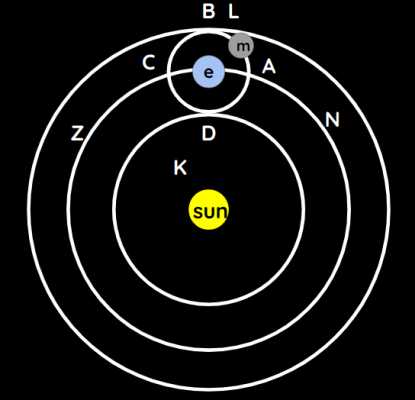How are the Orbits of the Moons Formed?
Table of Contents
Boats following the course of a river can never move as fast as the water that bears them.
- The larger boat cannot move as fast as the smaller.
Similarly, the planets move slower than the air-aether that they are in.
The inequality of their motion is relative to the inequality between:
- their mass and
- the smallness of the air-aether that surround them.
This is because, the larger a body:
- the easier it is for it to communicate its motion to other bodies
- the more difficult it is for the others to communicate their motion to it
Many small bodies all working together to act on a larger one may have as much force as it.
- But they can never make it move as fast as they in all directions.
- This is because they are not all united in the direction of the motion
This leads to 2 things:
- The air-aether must make the planets revolve around the sun and also rotate around their own center, except when there is some cause that hinders them.
Consequently, the air-aether creates small gravitational territories around the planets. These move in the same direction as the stellar gravitational territory.
- If two planets are at the same orbit, with one much larger and more massive than the other, then the smaller will be faster than the larger.
It will have to link itself to the gravitational territory of the larger and revolve around it, as its moon.
The air-aethers at A move faster than the planet e. They push e towards Z.

e in return pushes the air-aethers towards B instead of towards D. This is because the air-aethers are inclined to continue their motion in a straight line. And so they must go outside of the orbit ACZN which they create, rather than towards the sun.
Passing from A to B, they force planet e to turn with them around its center.*
- This then lets them go from
BtoC, then toDand toA.
Superphysics Note
Thus, they form a particular heliosphere around the planet. They continue to move from the West towards the East both:
- around the sun and
- around its own center.
m is disposed to take its course along orbit NACZ just like the planet e.
mmoves faster because it is smaller.- Wherever it might have been in the stellar gravitational territory at the start, it shortly would tend towards the exterior of the planetary gravitational territory
ABCD. - After joining
ABCD, it must always follow the orbit arounde, along with the air-aethers that are at the surface.- If
edid not exist,mwould have exactly as much force as the air-aether of territoryABCDto go along the orbitNACZ.
- If
mwould have a bit more force to turn along orbitABCDbecause it is smaller. This is why it always moves as far away as possible from the centere.- In the same way, a stone being moved in a sling always tends to move away from the center of the orbit that it is forming.
Yet m, being at A, will not move off towards L because the air-aether at L would push it back towards orbit NACZ.
-
Likewise, when it is at
C, it will not move towardsKbecause the air-aether there would force it to ascend again towards that same orbitNACZ. -
mwill not be flung fromBtowardsZ, much less fromBtowardsNbecause it only has the speed to go toCorA.
- Thus, it must remain attached to the surface of the small territory
ABCDand turn continually with it arounde.